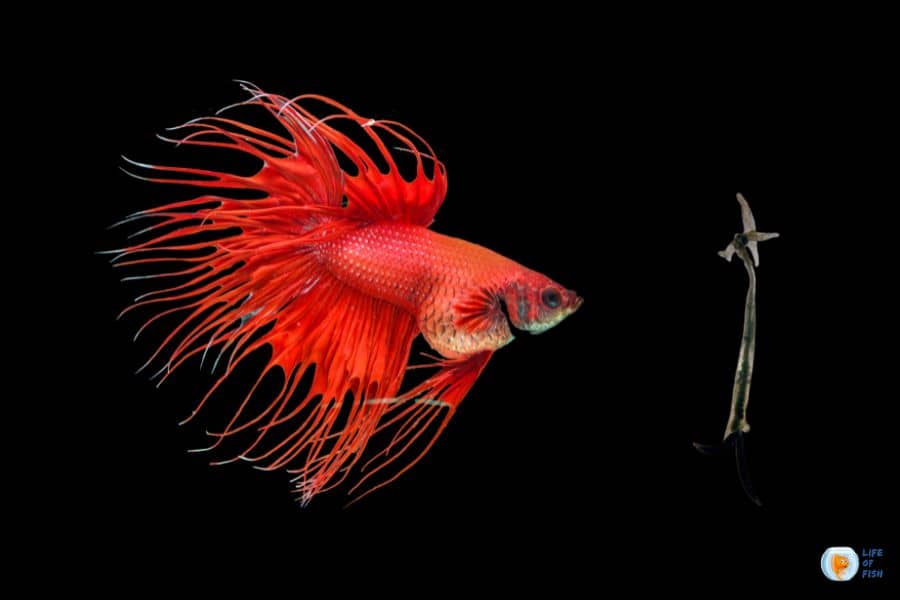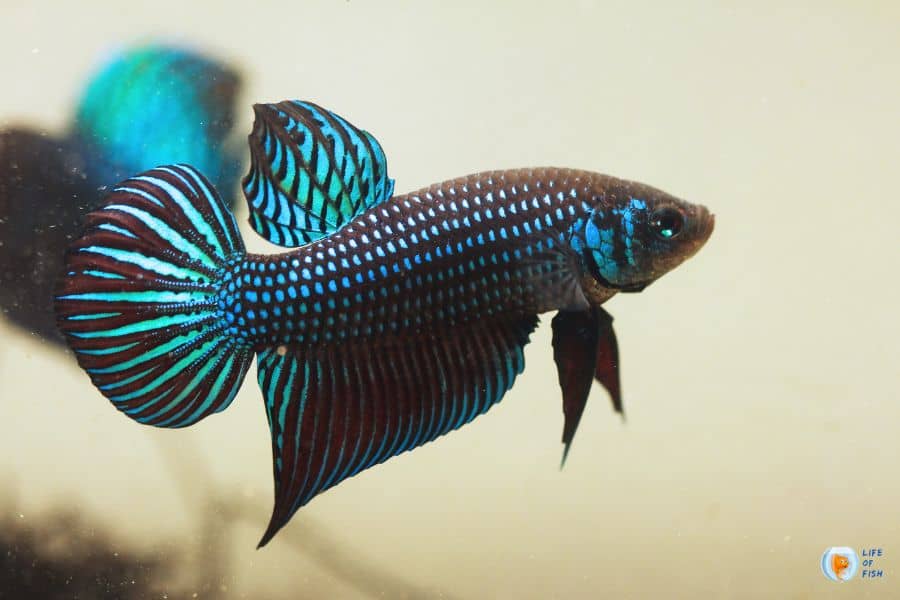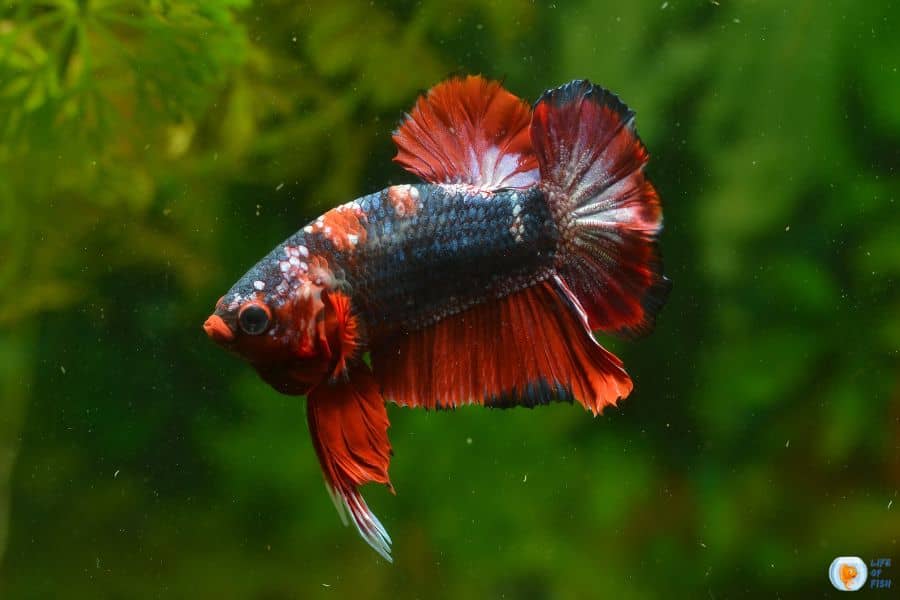Anchor worms are one of the most common parasitic threats to aquarium inhabitants. And it is important for aquarists to understand how best to deal with them if their tank becomes infested. I’m here to provide you with all the information you need on anchor worm infestations in betta tanks – from symptoms and causes to treatment options and prevention tips!

The good news is that there is hope when dealing with anchor worms; understanding what causes them. And you can recogniz early signs of an infestation will help ensure your betta remains healthy and parasite-free. So let’s take a look at everything you need to know about anchor worms on bettas!
“Is your Betta Fish showing signs of illness? Click here to learn about the different Betta Fish Diseases and how to care for your sick fish.” Betta Fish Diseases
What Are Anchor Worms?
Jump To
- 1 What Are Anchor Worms?
- 2 What Causes Anchor Worms
- 3 What Are The Symptoms Of Anchor Worms
- 4 How Do You Treat Anchor Worm In Bettas
- 5 How Do You Prevent Anchor Worms?
- 6 Are Anchor Worms Harmful To Your Betta?
- 7 How Do Anchor Worms Get Into Your Betta’S Tank?
- 8 What Kills Anchor Worms On Fish?
- 9 Should I Remove Anchor Worm?
- 10 What Do Anchor Worms Feed On?
- 11 Can Methylene Blue Kill Anchor Worms
- 12 Conclusion
Anchor worms are one of the many aquatic parasites that can affect fish. Comparable to an insidious disease, they worm their way into a host’s body and reproduce at alarming rates if left untreated. Anchor worms can be found on both fresh and saltwater fish, including bettas.
Anchor worm infestations are quite easy to identify. They are characterized by white thread-like appendages protruding from the skin or gills of infected hosts, . In addition to being visible externally, these parasitic creatures have claws that latch onto the tissue surrounding them. It makes it difficult for them to be removed without professional help. This is why identifying an infection early is essential so that proper treatment may begin promptly.
What Causes Anchor Worms
Anchor worms are parasites that typically affect freshwater aquarium fish, such as betta fish. There can be multiple causes of anchor worm infestations in an aquarium. The primary cause is poor water quality or a lack of proper maintenance. Here are some common causes of anchor worm infestation in betta fish and other aquatic pets:
- An unclean tank environment. A dirty tank can lead to various types of bacterial and fungal infections, including those caused by anchor worms.
- Poor water chemistry. The pH levels, alkalinity, hardness, ammonia and nitrates should all be within acceptable ranges for healthy aquatic life. When these parameters are off balance it can create conditions that favor certain parasites like anchor worms.
- Overfeeding. Uneaten food left floating on the surface will decay faster than normal. It is due to bacteria growth which leads to increased nutrient concentrations in the water column that attract parasites like anchor worms.
What Are The Symptoms Of Anchor Worms
The symptoms of anchor worms in bettas are often quite obvious. The fish will have a lumpy, white growth on its body where the worms attach themselves to the skin and scales. This area may become red and irritated due to the parasite’s feeding activity.
In some cases, the area will be slightly raised or protruding from the surface. You may also see reddish streaks along the sides of your fish that indicate blood loss caused by the parasites’ presence. Additionally, you can sometimes detect small worm-like creatures attached to areas like fins or gills if you look closely enough. If any of these signs are present, it is likely that your betta has been infected with anchor worms.
In extreme cases, an untreated infection can cause serious damage to tissues. It can even lead to death for your fish if left unchecked. Therefore, it is important to take measures quickly should you suspect anchor worms are present in your aquarium. So as not to risk further harm coming to your beloved pet.
How Do You Treat Anchor Worm In Bettas
Now that we understand the symptoms of anchor worms in bettas, let’s discuss how to treat them. Anchor worm treatment for bettas is a process and requires patience and dedication on your part. Here are four steps you can take:
- Remove any debris from the water where your betta lives. Anchor worms thrive in polluted waters so this step is essential if you want to get rid of them for good.
- Treat the tank with an anti-parasite medication specifically designed for freshwater fish. This will help kill off any remaining parasites and eggs.
- Change out 25% of the water weekly to keep the environment clean and free from pollutants that may attract anchor worms back into your aquarium again.
- Clean or replace all filters regularly as they can harbor hidden anchor worms which could re-infect your fish after treatment has finished.
It’s important to remember that treating anchor worms in bettas can be a long process, but it’s worth it when you see your fish happy, healthy, and parasite-free! With proper care and maintenance, you should be able to keep these pesky critters away from your pet betta forever! Now onto the next topic – how do you prevent anchor worms?
How Do You Prevent Anchor Worms?
Prevention is paramount when it comes to protecting your betta from anchor worms. Practicing prudent prevention practices can help you proactively protect against infestation, and stop a potential problem before it starts. Properly preparing the environment for your fishy friend is an excellent way of avoiding any kind of unwanted guests in their watery home.
To prevent an infestation of anchor worms in your betta’s habitat, be sure to regularly monitor the tank or bowl. Look closely at all surfaces and clean them if algae has built up on any areas, as this could attract small insects which may carry these parasites into the environment.
Additionally, make sure to change out some of the water every week so that it remains fresh, clean and parasite-free; 30% should do the trick! Finally, always quarantine new fish before adding them to existing aquariums –this will reduce the risk of introducing any unwelcome allies who might bring along unwelcomed hitchhikers with them.

Are Anchor Worms Harmful To Your Betta?
Anchor worms can be incredibly dangerous parasites that can cause a great deal of harm to your betta’s health. They attach themselves onto the fish’s body, causing damage and irritation, as well as consuming essential nutrients from their host. Here are four key points to keep in mind regarding anchor worm harm:
- Anchor worms can cause serious skin ulcerations on a betta’s body if left untreated.
- The parasite may consume its host’s vital nutrition and weaken the infected fish over time.
- There is potential for secondary infections from bacteria or other organisms that enter through wounds caused by the worm.
- Serious cases of an infestation could result in death if not treated promptly with a suitable medication or remedy.
It’s important to monitor your betta closely for signs of infection such as erratic behavior, loss of appetite, clamped fins or redness around their gills and mouth area, which could all indicate a possible problem with harmful effects from anchoring worms on their health.
If you spot any of these symptoms it’s best to seek professional advice immediately before the situation becomes more severe and potentially life-threatening for your betta friend! With prompt action there should be no need to worry about long term complications due to this dangerous parasite – but prevention is always better than cure when it comes to keeping our aquatic friends safe and healthy! Without further ado let us move onto how do anchor worms get into your betta’s tank?
How Do Anchor Worms Get Into Your Betta’S Tank?
Anchor worm infestations can be an unwelcome surprise to any betta keeper. But how do these parasites get into your tank in the first place? The exact sources of anchor worms vary, but there are some common factors that make certain conditions favorable for them.
Poor water quality, overcrowded tanks, and inadequate filtration all contribute to making a tank more inviting for anchor worms to take up residence. Additionally, anchoring worms can also spread via contact with other infected fish or plants, so it’s important to quarantine any new additions before introducing them into a shared environment.
Prevention is key when it comes to avoiding an anchor worm infestation. Maintaining good water conditions, not overstocking tanks, using appropriate filtration systems — as well as regularly inspecting both fish and plants — will help keep your betta safe from these pests!
What Kills Anchor Worms On Fish?
Now that we know how anchor worms get into your betta’s tank, let’s talk about treating them. Anchor worms are pesky little pests, but luckily there are a few different treatments available to help kill them off.
The most effective and safest treatment is the use of methylene blue fish medication. This will target the larvae of the anchor worm and stop it from developing further. You can also be use it as an anti-fungal agent in addition to killing off adult anchor worms.
Additionally, you may want to consider using salt baths or hydrogen peroxide dips to treat any existing infestations. These methods are often very effective in killing off adult anchor worms quickly and easily without harming your betta or other fish in the tank.
However, if these methods don’t completely eradicate all of the anchor worms, then you may need to resort to more intensive treatments such as chemical solutions or manual removal of infected areas with tweezers.
Regardless of which method you choose for treating anchor worms on fish, make sure to keep up regular water changes and cleanings so that new infestations don’t occur again down the road. With proper care and maintenance, you should have no problem keeping this pest away from your beloved betta for good!
Should I Remove Anchor Worm?
It is important to remove anchor worms as soon as they are detected in a betta fish tank. The longer the parasite remains, the more severe its effects can become on the health of your fish.
Anchor worm removal should be done with caution and care, using safe methods intended for aquatic animals. Start by identifying any infected areas on your betta’s body or fins. If present, these parasites will look like small white bumps which may have black tips protruding from them.
To get rid of anchor worms safely, use tweezers to gently pull out each one individually. Don’t forget to apply aquarium-safe medication afterwards to prevent further infestations and treat existing ones. It is also essential to keep up with regular water changes to reduce ammonia levels that allow parasites such as this one to thrive in an environment where oxygen levels are low.
Finally, it is recommended that you employ preventive measures such as proper nutrition, prevention of overcrowding, and avoiding pH shock when introducing new species into an established system; all of which can help minimize the risk of anchor worm infections in your tank.
What Do Anchor Worms Feed On?
The anchor worm’s diet is as mysterious as the ocean depths, where it resides. Like a diver in search of sunken treasure, its feeding habits are an enigma to many aquarists. Anchor worms feed mostly on organic material such as decaying plant matter and detritus, but they may also consume small crustaceans or other aquatic organisms if available. They have been observed eating algae off of fish and can even latch onto live tissue for sustenance.
Anchor worms provide important nutrition to their hosts through injecting digestive enzymes into their prey that break down the food particles so they can be absorbed by both parties. This symbiotic relationship helps balance out the ecosystem within your aquarium environment.
As with any species, there must be careful consideration given to ensure that this vital nutrient source remains sustainable over time. Proper tank management will aid in maintaining optimal conditions for all inhabitants, which includes providing adequate nutrition for anchor worms.

Can Methylene Blue Kill Anchor Worms
Methylene blue is a common treatment for anchor worms in bettas and other fish. It can be used both as a preventative measure and to kill active infestations of the parasites.
In its aquatic form, methylene blue works by disrupting the respiration process of the anchor worm larvae which results in their death. As an added benefit, it also helps to reduce stress on affected fish by providing some relief from irritation caused by the presence of these parasites.
When using methylene blue to treat anchor worms in bettas, make sure that you follow instructions carefully to ensure optimal effectiveness and safety. Start off with a small dose because too much could cause harm to your fish or simply not work at all due to over-saturation.
Once you have determined how much your fish needs, increase the dosage slightly if needed but always monitor closely for signs of adverse reactions like lethargy or color changes before escalating further use.
To help support successful eradication of anchor worms, perform frequent water changes after administering treatments as this will improve water quality and thus help speed up recovery time for your fish.
Conclusion
Our conclusion is that anchor worms are irritating and potentially dangerous pests for our betta fish. In order to properly protect their health, it’s important to know what they look like and how to treat them if they appear. Methylene blue can be used as an effective treatment against anchor worms, but prevention should still be the primary goal.
Like a thief in the night, anchor worms will often sneak up on unsuspecting betta owners before causing noticeable damage or distress. But just like any good guardian of aquatic life would do, we must stay ever vigilant so that these unwelcome visitors don’t have a chance to spread disease or cause harm.
Being aware of common signs of anchor worm infestation and taking preventive measures such as proper aquarium maintenance can help us win the battle against this slimy pest. With knowledge and care, we can keep our beloved bettas healthy and safe from parasites like the dreaded anchor worm.
Read Next: Betta Fish Ich: Causes, Symptoms, and Treatment
Read Next: Betta Hole In Head: Causes, Symptoms, and Ways to Prevent It
